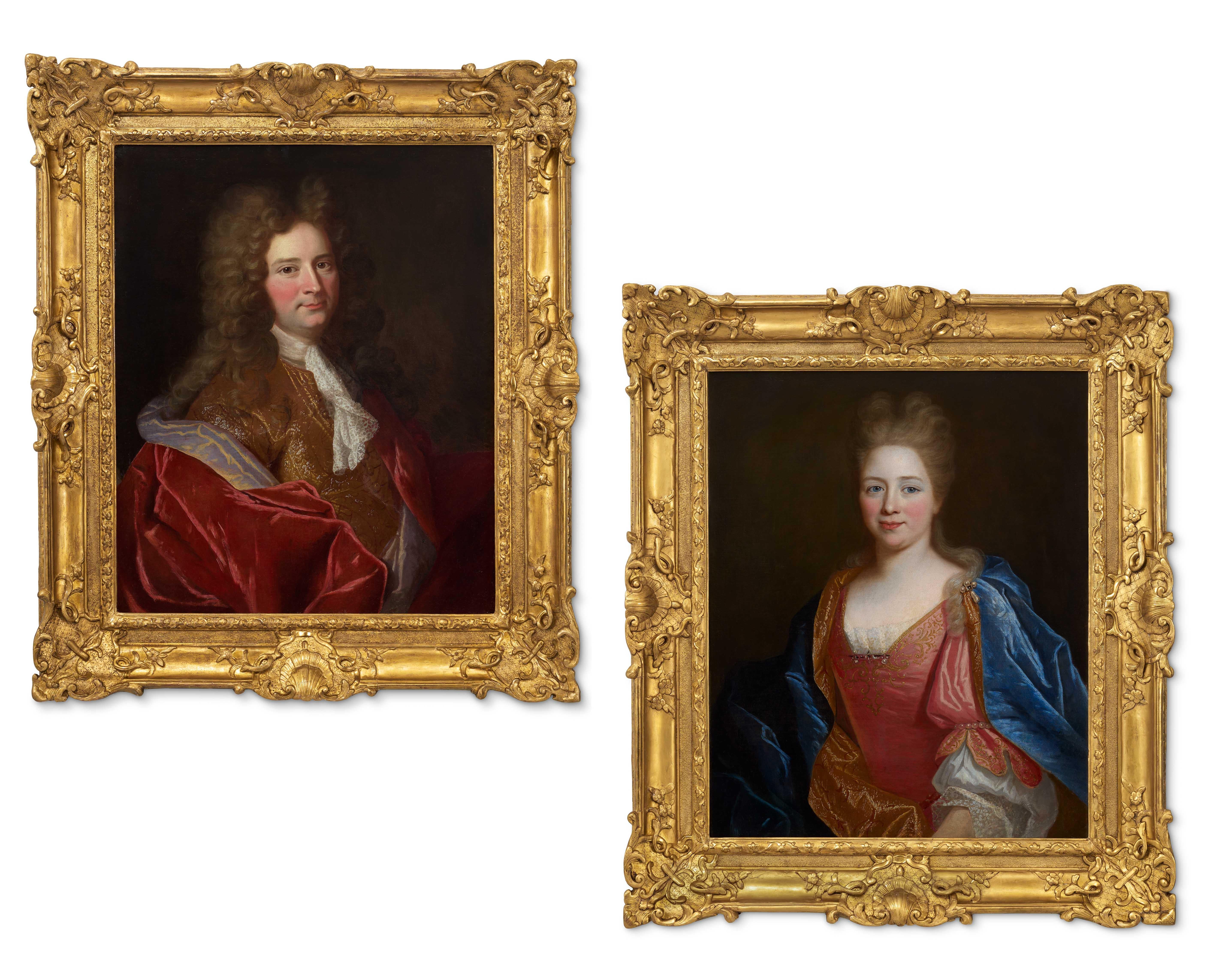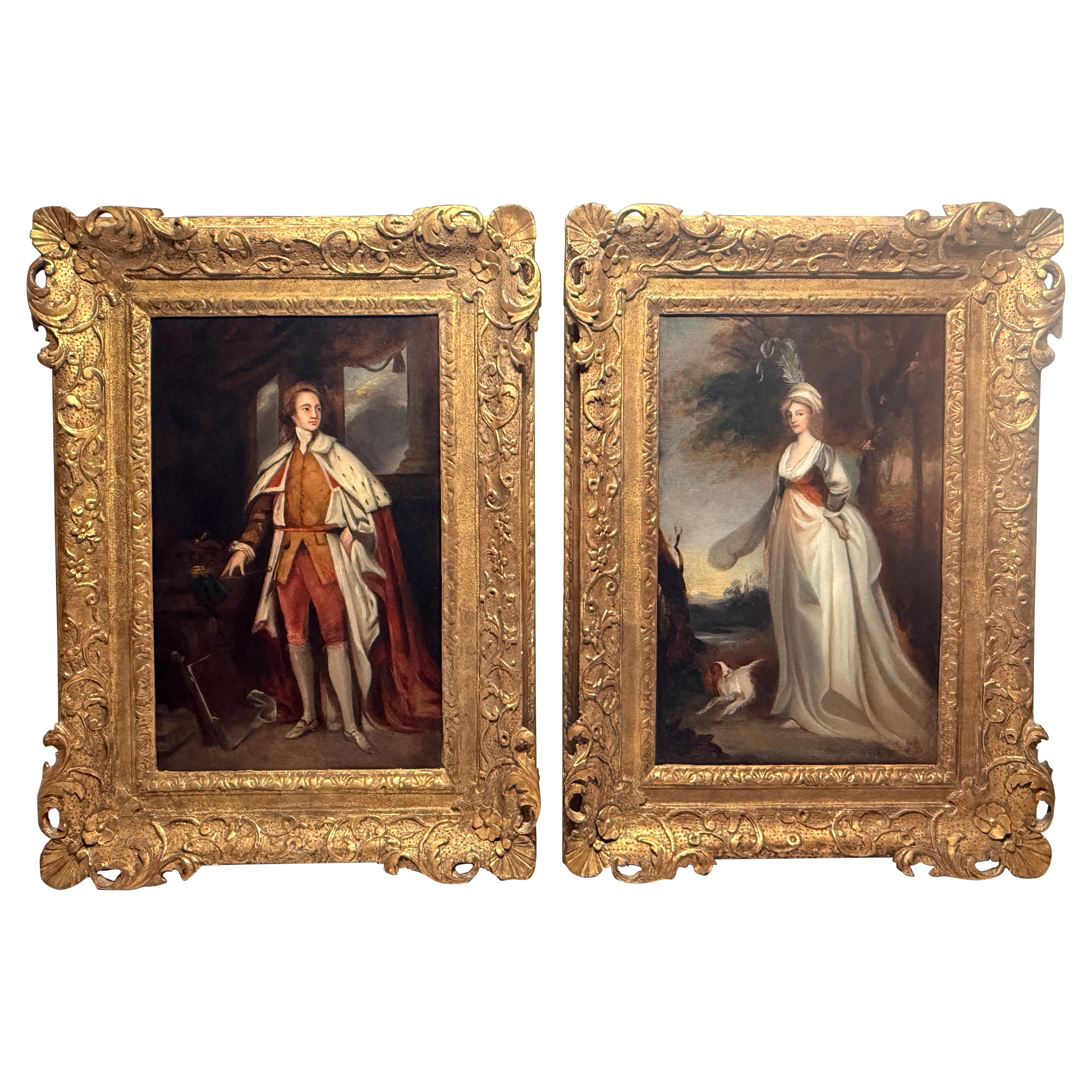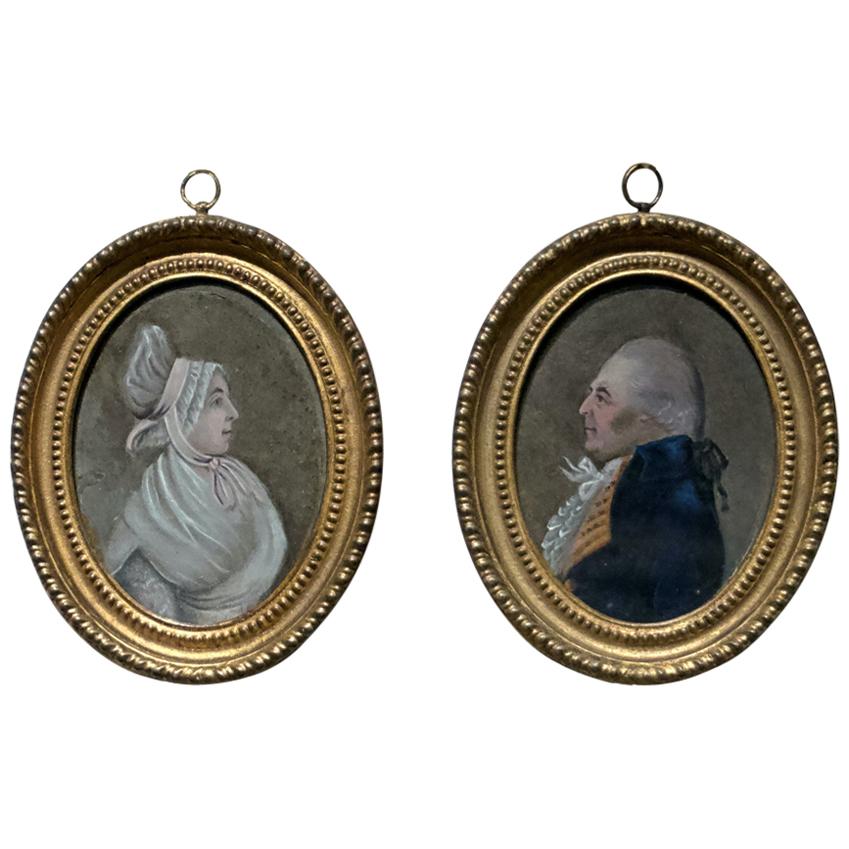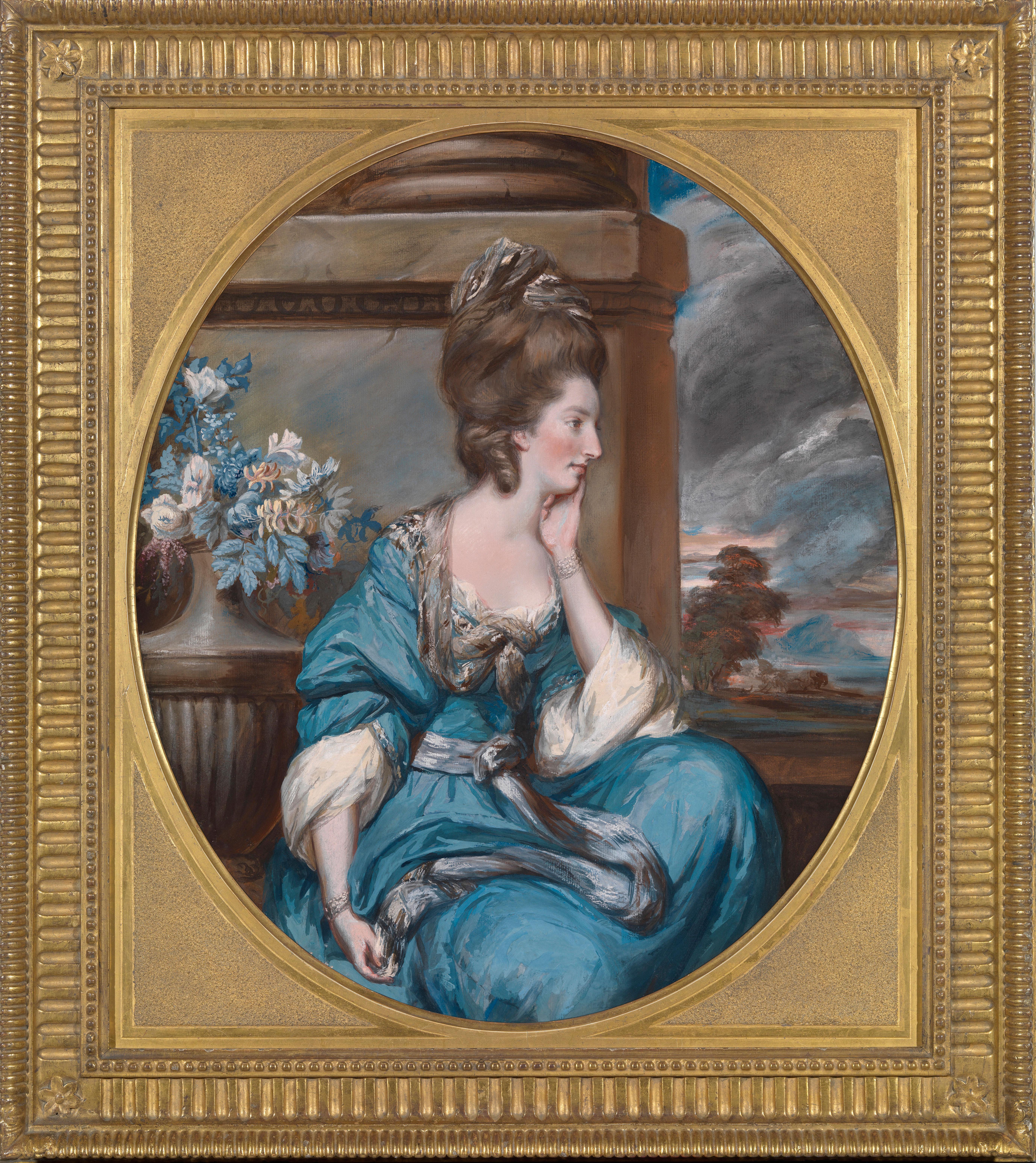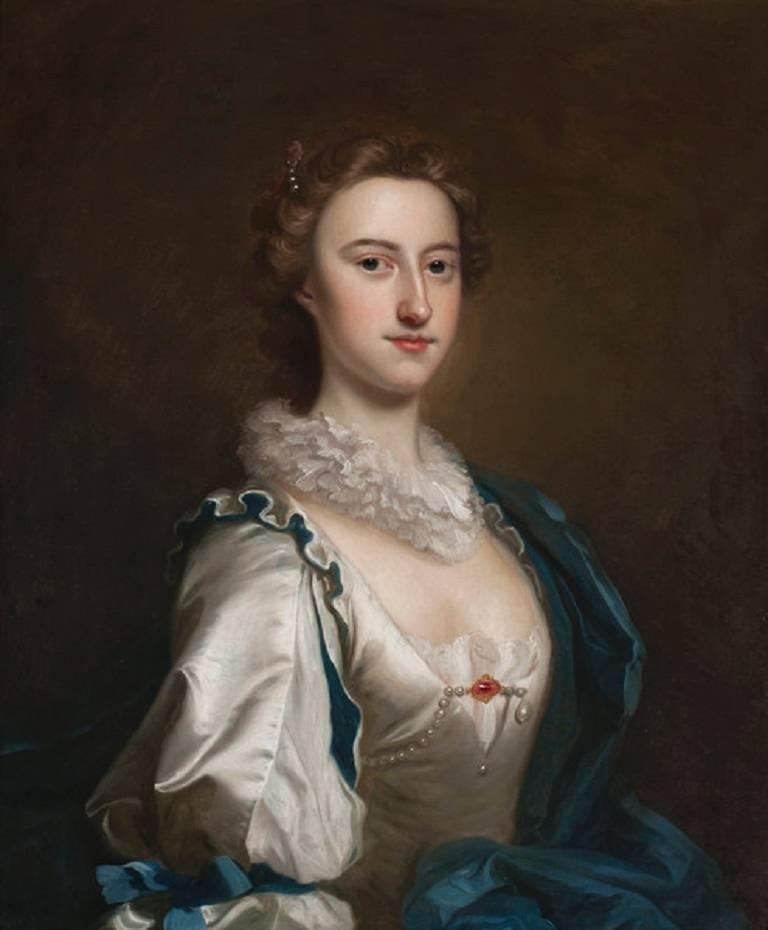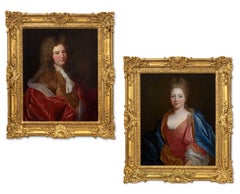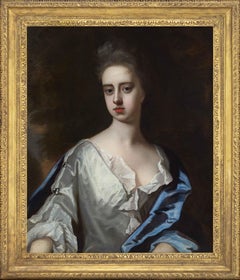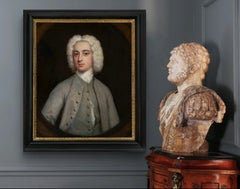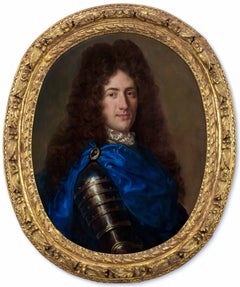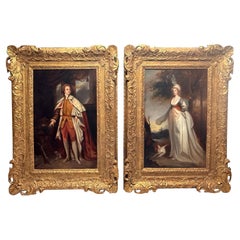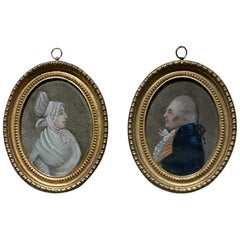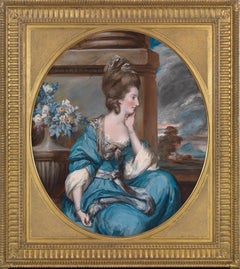Items Similar to Portrait of Gentleman Blue & Cloak, Portrait of Lady, Fine Carved Gilded frames
Want more images or videos?
Request additional images or videos from the seller
1 of 15
Thomas MurrayPortrait of Gentleman Blue & Cloak, Portrait of Lady, Fine Carved Gilded framescirca 1697
circa 1697
$27,762.47
£20,250
€23,651.68
CA$38,678.81
A$42,097.20
CHF 22,100.65
MX$508,595.68
NOK 277,387.61
SEK 261,543.70
DKK 176,557.68
About the Item
Portrait of a Gentleman with Blue Cloak and Portrait of a Lady in Russet Dress c.1697
Thomas Murray (1663-1735)
These fascinating portraits are exquisite examples of portraiture in England during the end of the seventeenth century. Painted by Thomas Murray, who can be described as one of the most successful and talented artists during the last part of the seventeenth century; it is not surprising that Murray painted the portraits of King William III, Queen Mary, Queen Ann as well as several other high-ranking individuals. They are noteworthy in their excellent state of preservation and their remarkable quality; they are amongst Murray’s finest works, and are presented in an outstanding carved and gilded antique frames, which are fine work of art in themselves.
The sitters are most likely husband and wife as he is inclined to is elegantly attired in a blue silk dress over a white frilled chemise and a striking crimson mantle. The right facing stance of the gentleman and the lady slightly inclined to our left, suggests that the couple were married, according to the traditional rules of marriage portraiture at the time.
The portrait genre was valued particularly highly in English society. Neither landscapes nor allegorical pictures were ever priced so highly at exhibitions and in the trade as depictions of people, from the highest aristocracy to scholars, writers, poets and statesmen.
These portraits can be dated to circa 1697 based on the fashionable hair and clothing styles. The lady’s russet coloured dress is held in place on the bodice by a huge diamond and gold brooch, the azure silk scarf is suspended in the air and flows off the pictoral space, a deliberate attempt by the artist to create a sense of movement, away from a ‘standard’ portrait. The gentleman wears a shimmering striking blue cloak over a white lace cravat, his hair is worn natural instead of a wig. The strong and vibrant blue pigment in his cloak is indicative of the remarkable state of preservation of this portrait; blue pigment from this period today often appears faded and abraded. This is a very fine example.
Murray’s work retains an individual style and easily distinguishable by a refined and elegant manner. He also favoured the exaggerated horizontal flowing mantle for both his female and males’ sitters, as seen in our portrait of the lady, and also placed male sitters with the shoulder prominently facing the viewer. This illustrates the studio practice at the time; when an artist found success with a formula they were not afraid to repeat it. Murray’s earlier work is similar to John Closterman, who was a fellow pupil, and many consider this period to be his finest.
Thomas Murray was born in Scotland but moved to London to study with a member of the De Critz family. Later he was a pupil of the English portraitist John Riley (1646-1691), who was court painter to King William III and Queen Mary, and was practising as a painter on his own in the 1680s. In 1691 he took over Riley’s studio when that artist died in 1691 and he established a very successful practice.
The Rev, James Dalloway accounted that Murray “was remarkable for his personal beauty and for the elegance of his manner” and he was also noted to have been hard working, courteous and popular with his customers.
Murray invested wisely in property and raised a considerable sum by lending money; when he died in 1735, he left around £40,000. He had no children and he bequeathed his money to a nephew with instructions that his monument, with a bust, should be erected in Westminster Abbey, provided that it did not cost too much – but his nephew decided that it was indeed “too expensive” and the plan did not proceed. He is buried in St. Paul's Church in Covent Garden, London.
Murray’s work is represented in many British country houses and private collections, the National Portrait Gallery London, Royal Society and Middle Temple in London, and in the Uffizi Gallery in Florence.
Each painting offered for sale by Titan Fine Art has been assessed by a professional conservator prior to going on sale. Thus, all paintings are in good condition, requiring no work, and can be hung and enjoyed immediately.
Measurements: Height 96cm, Width 85cm, Depth 7cm framed (Height 37.75”, Width 33.5”, Depth 2.75” framed)
- Creator:Thomas Murray (1663 - 1734)
- Creation Year:circa 1697
- Dimensions:Height: 37.8 in (96 cm)Width: 33.47 in (85 cm)Depth: 2.76 in (7 cm)
- Medium:
- Movement & Style:
- Period:
- Condition:The condition is very good and can be hung and enjoyed immediately. The painting has passed a strict condition assessment by a professional conservator prior to going on sale.
- Gallery Location:London, GB
- Reference Number:1stDibs: LU1199116338852
About the Seller
5.0
Vetted Professional Seller
Every seller passes strict standards for authenticity and reliability
Established in 1998
1stDibs seller since 2019
45 sales on 1stDibs
Typical response time: 1 hour
- ShippingRetrieving quote...Shipping from: London, United Kingdom
- Return Policy
Authenticity Guarantee
In the unlikely event there’s an issue with an item’s authenticity, contact us within 1 year for a full refund. DetailsMoney-Back Guarantee
If your item is not as described, is damaged in transit, or does not arrive, contact us within 7 days for a full refund. Details24-Hour Cancellation
You have a 24-hour grace period in which to reconsider your purchase, with no questions asked.Vetted Professional Sellers
Our world-class sellers must adhere to strict standards for service and quality, maintaining the integrity of our listings.Price-Match Guarantee
If you find that a seller listed the same item for a lower price elsewhere, we’ll match it.Trusted Global Delivery
Our best-in-class carrier network provides specialized shipping options worldwide, including custom delivery.More From This Seller
View AllPortrait of a Lady and Portrait of Gentleman, Velvet & Silk Attire c.1700 French
By Nicolas de Largillière
Located in London, GB
These lavish portraits, presented by Titan Fine Art, illustrate the elegant and exuberant type of portrait that the French court and the bourgeoisie favoured at the end of the 17th c...
Category
17th Century Old Masters Portrait Paintings
Materials
Canvas, Oil
Portrait of a Lady White Dress & Blue Cloak, Frances Temple Lady Berkeley canvas
By Michael Dahl
Located in London, GB
Portrait of a Frances Temple Lady Berkeley in a White Dress and Blue Mantle c.1695
By Michael Dahl (1659-1743)
This elegant and graceful portrait, presented by Titan Fine Art, was p...
Category
17th Century Old Masters Portrait Paintings
Materials
Cotton Canvas, Oil
Portrait of a Gentleman in Grey Coat & White Cravat, Oil on canvas Painting
Located in London, GB
This exquisite work, presented by Titan Fine Art, is by the notable artist Hans Hysing, who was a noteworthy painter in England; it is significant in its q...
Category
18th Century Old Masters Portrait Paintings
Materials
Canvas, Oil
Portrait Gentleman Armour, Blue Cloak, Diamond Brooch c.1700 French Carved Frame
By Joseph Vivien
Located in London, GB
Portrait of a Gentleman in Armour and Azure Cloak with Diamond Brooch c.1700
Attributed to Joseph Vivienne (1657-1735)
The sitter in this superb portrait, offered by Titan Fine Art...
Category
17th Century Old Masters Portrait Paintings
Materials
Oil, Cotton Canvas
Portrait of a Lady, Elizabeth Fane, Countess Westmoreland in Silver Dress, oil
By John Michael Wright
Located in London, GB
Portrait of a Lady, Elizabeth Fane, Countess Westmoreland in Silver Dress c.1667
Circle of John Michael Wright (1617-94)
In this touching composition, painted around the time of Lon...
Category
17th Century Old Masters Portrait Paintings
Materials
Cotton Canvas, Oil
Portrait of a Lady in Green Dress & Pearl Jewellery c.1660 Painting John Wright
By John Michael Wright
Located in London, GB
In this exquisite work, painted around the time of the Great Fire of London in 1666, a beautiful young woman is wearing a green dress over a white chemise and a russet-coloured scarf...
Category
17th Century Old Masters Portrait Paintings
Materials
Canvas, Oil
You May Also Like
Pair, Portrait Paintings Depicting King George IV and Queen Caroline Circa 1800
By (circle of) Thomas Gainsborough
Located in Atlanta, GA
**Pair of Portrait Paintings Depicting King George IV and Queen Caroline, Attributed British School, Early 19th Century**
Oil on canvas - laid to board and backed with wood panel.
M...
Category
Antique Early 19th Century English Regency Paintings
Materials
Giltwood, Paint
$3,040 Sale Price / set
20% Off
Pair of Miniature Portraits in Giltwood Frames
Located in Huntington, NY
2 portraits, late 18th century, oil on board.
Category
Antique 1790s English George III Paintings
Materials
Pine, Giltwood
$1,136 Sale Price
20% Off
Portraits King Louis XV Queen Gobert Paint Oil on canvas old master 18th Century
Located in Riva del Garda, IT
Pierre Gobert (Fontainebleau 1662 - Paris 1744) Atelier of
Pair of fine portraits
Louis XV, King of France and his wife, Maria Leszczyńska
oils on canvas (2), 41 x 32 cm., in frame 53 x 44 cm.
It is easy to identify the sitters of this charming pair of portraits in the rulers of France, namely Louis XV of Bourbon, who ascended the throne in 1715 at the age of just thirteen and was nicknamed the 'Beloved', and Maria Leszczyńska, Queen Consort of France and Navarre and daughter of the King of Poland Stanislaus I.
The queen is depicted in a three-quarter-length figure, her face smiling and turned towards the spectator. She wears a wig in shades of grey with her hair gathered around the nape of her neck and a diadem on her head, and pendants on her ears. She wears a dress with a wide neckline made of red velvet, brocaded with gold threads, with rich lace sleeves, and a bodice adorned with a jewelled bodice of diamonds and pearls. On the shoulders rests a blue velvet mantle embroidered with the heraldic...
Category
18th Century Old Masters Paintings
Materials
Oil
$9,836 Sale Price
20% Off
Portraits of the Hon. Mary Shuttleworth and Anna Maria, 9th Baroness Forrester
By Daniel Gardner
Located in London, GB
THE HON. MARY SHUTTLEWORTH, NÉE COCKBURN (D. 1777)
and her sister
ANNA MARIA, 9TH BARONESS FORRESTER (D. 1808)
Pastel and gouache on paper laid on canvas, on their original backb...
Category
18th Century Old Masters Portrait Drawings and Watercolors
Materials
Pastel, Gouache
Portrait of a Lady, Old Masters 18th Century Oil
By Thomas Hudson
Located in London, GB
Thomas Hudson
1701 – 1779
Portrait of a Lady
Oil on canvas
Image size: 30 x 25 inches
Original carved giltwood frame
Hudson had many assistants, and employed the specialist drapery ...
Category
18th Century Old Masters Portrait Paintings
Materials
Canvas, Oil
18th century portrait of sisters Lady Catherine and lady Jane Brydges
By James Maubert
Located in Bath, Somerset
This large double portrait depicts the sisters Lady Catherine and Lady Jane Brydges, the daughters of John Brydges, the Marquess of Carnarvon (1703-1727). They are seated on a stone...
Category
Early 18th Century Old Masters Portrait Paintings
Materials
Canvas, Oil
More Ways To Browse
Gilded Frame
Carved And Gilded Frame
Gilded Painting
Westminster Abbey
Antique Cravat
Huge Brooch
Antique Chemise
King William Iii
Oil Painting Gilded Frame
Gilded Portrait
Antique Silk Scarf
John Riley
Spanish Jewish
Terry Shelbourne
Tiziano Vecellio
16th Century Religious Painting
1860 Oil Painting Of Woman In Black Dress
Antique Oil Painting Skull
